University of Cambridge
| University of Cambridge | |
|
Hinc lucem et pocula sacra | |
|---|---|
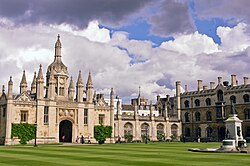 King's College, Cambridge | |
| Founded: | 1209 |
| Chancellor: | The Lord Sainsbury of Turville |
| Type: | Urban |
| No. of colleges: | 31 |
| No. of students: | {{{students}}} |
| Faculty: | 5,999 |
| Endowment: | £4.9 billion (2013, incl. colleges) |
| Website: | www.cam.ac.uk |
| Location | |
The University of Cambridge is one of the greatest universities in the world. It consists of 31 colleges and six academic schools and attendant institutions in and around the City of Cambridge, in Cambridgeshire.
Cambridge is the oldest university in the English-speaking world after the University of Oxford, and the third-oldest surviving university in the world. It is a public research university and considered to be one of the most prestigious institutions of higher learning in the world.[1]
The university grew out of an association of scholars that was formed in 1209, early records suggest, by scholars leaving Oxford after a dispute with townsfolk.[2] The two "ancient universities" have many common features and are often jointly referred to as Oxbridge.
A total of 89 Nobel Prizes winners are affiliates of the university.[3]
In post-nominals the university's name is abbreviated as Cantab, a shortened form of Cantabrigiensis (from the Mediaeval Latin name for Cambridge; Cantabrigia).
Colleges
The colleges are self-governing institutions with their own endowments and property, founded as integral parts of the university. All students and most academics are attached to a college. Their importance lies in the housing, welfare, social functions, and undergraduate teaching they provide. All faculties, departments, research centres, and laboratories belong to the university, which arranges lectures and awards degrees, but undergraduates receive their supervisions—small-group teaching sessions, often with just one student—within the colleges. Each college appoints its own teaching staff and fellows, who are also members of a university department. The colleges also decide which undergraduates to admit to the university, in accordance with university regulations.
List of the colleges
Cambridge has 31 colleges:
| Arms | Scarf colours | Foundation | Founder | Fixed assets (£) | Website | Notes |
|---|---|---|---|---|---|---|
| The University of Cambridge | ||||||
| cam.ac.uk | ||||||
| Christ's College | ||||||
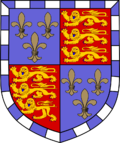 |
1505 | William Byngham (1437) Lady Margaret Beaufort (1505) |
£66,602,000 | christs.cam.ac.uk | ||
| Churchill College | ||||||
 |
1960 | £105,978,346 | chu.cam.ac.uk | |||
| Clare College | ||||||
| 1326 | Richard Badew, 1326 Elizabeth de Clare, 1338 |
£70,707,000 | clare.cam.ac.uk | |||
| Clare Hall | ||||||
 |
1965 | Clare College | £10,579,203 | clarehall.cam.ac.uk | Graduate students only. | |
| Corpus Christi College The College of Corpus Christi and the Blessed Virgin Mary in the University of Cambridge | ||||||
 |
1352 | The Guild of Corpus Christi, The Guild of the Blessed Virgin Mary |
£191,233,087 | corpus.cam.ac.uk | ||
| Darwin College | ||||||
| 1964 | Trinity, St John's and Gonville and Caius Colleges | £33,160,032 | dar.cam.ac.uk | Graduate students only. | ||
| Downing College | ||||||
| 1800 | Sir George Downing | £86,798,000 | dow.cam.ac.uk | |||
| Emmanuel College | ||||||
 |
1584 | Sir Walter Mildmay | £152,640,692 | emma.cam.ac.uk | ||
| Fitzwilliam College | ||||||
 |
 |
1869 (1966) | University of Cambridge | £43,509,000 | fitz.cam.ac.uk | Attained collegiate status in 1966 |
| Girton College | ||||||
| 1869 | Emily Davies, Barbara Bodichon, Lady Stanley of Alderley |
£64,000,000 | girton.cam.ac.uk | At Girton. Founded for ladies only; became mixed in 1976 | ||
| Gonville and Caius College | ||||||
| 1348 | Edmund Gonville (1348) John Caius (1557) |
£159,332,000 | cai.cam.ac.uk | |||
| Homerton College | ||||||
 |
1895 (1976) | £123,453,808 | homerton.cam.ac.uk | Founded as Homerton Academy (1768-1852). Achieved collegiate status 2010 | ||
| Hughes Hall Elizabeth Phillips Hughes Hall Company | ||||||
| 1885 | £18,483,546 | hughes.cam.ac.uk | Mature undergrad, and grad students only. Became mixed in 1973. | |||
| Jesus College The College of the Blessed Virgin Mary, Saint John the Evangelist and the glorious Virgin Saint Radegund, within the City and University of Cambridge | ||||||
 |
1496 | John Alcock | £242,995,403 | jesus.cam.ac.uk | ||
| King's College The King's College of Our Lady and Saint Nicholas in Cambridge | ||||||
| 1441 | King Henry VI | £155,618,000 | kings.cam.ac.uk | |||
| Lucy Cavendish College | ||||||
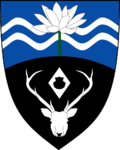 |
1965 | £24,323,000 | lucy-cav.cam.ac.uk | Mature female undergrad, and female grad students only. | ||
| Magdalene College The College of Saint Mary Magdalene | ||||||
 |
1428 | John Lytlington, Abbot of Crowland (1428) Thomas, 1st Baron Audley (1542) |
£73,763,845 | magd.cam.ac.uk | ||
| Murray Edwards College Murray Edwards College, founded as New Hall, in the University of Cambridge | ||||||
 |
1954 | £52,852,893 | murrayedwards.cam.ac.uk | Female only. Named 'New Hall' until 2008. | ||
| Newnham College ' | ||||||
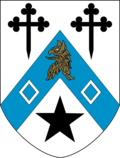 |
1871 | Henry Sidgwick Millicent Fawcett |
£90,287,969 | newn.cam.ac.uk | Female students only. At Newnham | |
| Pembroke College The College or Hall of Valence Mary (commonly called Pembroke College) in the University of Cambridge | ||||||
| 1347 | Marie de St Pol, Countess of Pembroke | £103,991,180 | pem.cam.ac.uk | |||
| Peterhouse ' | ||||||
 |
1284 | Hugo de Balsham, Bishop of Ely | £171,887,000 | pet.cam.ac.uk | ||
| Queens' College The Queen's College of St Margaret and St Bernard, commonly called Queens' College, in the University of Cambridge | ||||||
| 1448 | Margaret of Anjou (1448) Elizabeth Woodville (1465) |
£57,310,511 | quns.cam.ac.uk | |||
| Robinson College | ||||||
| 1977 | Sir David Robinson | £24,863,000 | robinson.cam.ac.uk | |||
| St Catharine's College The College or Hall of Saint Catharine the Virgin in the University of Cambridge | ||||||
| 1473 | Robert Wodelarke | £68,797,000 | caths.cam.ac.uk | |||
| St Edmund's College | ||||||
 |
1896 | Henry Fitzalan-Howard Duke of Norfolk, Baron Anatole von Hügel |
£8,381,224 | st-edmunds.cam.ac.uk | Mature undergrad, and grad students only. Achieved collegiate status in 1996 | |
| St John's College The College of St John the Evangelist of the University of Cambridge | ||||||
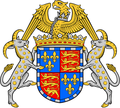 |
 |
1511 | Lady Margaret Beaufort | £567,390,000 | joh.cam.ac.uk | |
| Selwyn College | ||||||
 |
1882 | The Selwyn Memorial Committee | £69,992,285 | sel.cam.ac.uk | ||
| Sidney Sussex College The College of the Lady Frances Sidney Sussex | ||||||
 |
1596 | Frances Sidney, Countess of Sussex | £64,952,747 | sid.cam.ac.uk | ||
| Trinity College The College of the Holy and Undivided Trinity | ||||||
 |
1546 | King Henry VIII | £621,000,000 | trin.cam.ac.uk | ||
| Trinity Hall The College of Scholars of the Holy Trinity of Norwich | ||||||
 |
1350 | William Bateman, Bishop of Norwich | £208,176,916 | trinhall.cam.ac.uk | ||
| Wolfson College | ||||||
| 1965 | £47,307,000 | wolfson.cam.ac.uk | Mature undergrad, and grad students only. | |||
| ("Wikimedia Commons" has material about Arms of the University of Cambridge) |
Theological colleges
There are also several theological colleges in Cambridge that are affiliated with the university through the Cambridge Theological Federation. These colleges, while not officially part of the University of Cambridge, operate programmes that are either validated by or are taught on behalf of either the University or Anglia Ruskin University. These include:
- Ridley Hall
- Wesley House
- Westcott House
- Westminster College
Admission
Of the 31 colleges, three (Murray Edwards, Newnham and Lucy Cavendish) admit women only. The other colleges are mixed, though most were originally all-male. Darwin was the first college to admit both men and women, while Churchill, Clare, and King's were the first previously all-male colleges to admit female undergraduates, in 1972. In 1988, Magdalene became the last all-male college to accept women.
Clare Hall and Darwin admit only postgraduates, and Hughes Hall, Lucy Cavendish, St Edmund's and Wolfson admit only mature students, which is to say those of 21 years or older on date of matriculation, which encompasses both undergraduate and graduate students. All other colleges admit both undergraduate and postgraduate students with no age restrictions.
Specialisms and character
Colleges are not required to admit students in all subjects, with some colleges choosing not to offer subjects such as architecture, history of art or theology, but most offer close to the complete range. Some colleges maintain a bias towards certain subjects, for example with Churchill leaning towards the sciences and engineering,[4] while others such as St Catharine's aim for a balanced intake.[5]
Some colleges have much more informal reputations, such as the reputation for the students of King's College to hold left-wing political views,[6] or Robinson College and Churchill College's attempts to minimise its environmental impact.[7]

Schools, faculties and departments
In addition to the 31 colleges, the university is made up of over 150 departments, faculties, schools, syndicates and other institutions. Members of these are usually also members of one of the colleges and responsibility for running the entire academic programme of the university is divided amongst them. The university also houses the Institute of Continuing Education, a centre for part-time study.

A "School" in the University of Cambridge is a broad administrative grouping of related faculties and other units. Each has an elected supervisory body—the "Council" of the school—comprising representatives of the constituent bodies. There are six schools:[8]
|
|
Teaching and research in Cambridge is organised by faculties. The faculties have different organisational sub-structures which partly reflect their history and partly their operational needs, which may include a number of departments and other institutions. In addition, a small number of bodies entitled 'Syndicates' have responsibilities for teaching and research, for example Cambridge Assessment, the Cambridge University Press, and the University Library.
History
The official founding of Cambridge University is traced to the enhancement, by a charter in 1231 from King Henry III, which awarded the ius non trahi extra (a right to discipline its own members) plus some exemption from taxes. A papal bull in 1233 from Pope Gregory IX that gave graduates from Cambridge the right to teach "everywhere in Christendom".[9]
After Cambridge was described as a studium generale in a letter by Pope Nicholas IV in 1290,[10] and confirmed as such in a bull by Pope John XXII in 1318,[11] it became common for researchers from other European mediæval universities to visit Cambridge to study or to give lecture courses.[10]
Foundation of the colleges

The colleges at the University of Cambridge were originally an incidental feature of the system. No college is as old as the university itself. The colleges were endowed fellowships of scholars. There were also institutions without endowments, called hostels. The hostels were gradually absorbed by the colleges over the centuries, but they have left some indicators of their time, such as the name of Garret Hostel Lane.[12]
Hugh Balsham, Bishop of Ely, founded Peterhouse in 1284, Cambridge's first college. Many colleges were founded during the fourteenth and fifteenth centuries, but colleges continued to be established throughout the centuries to modern times, although there was a gap of 204 years between the founding of Sidney Sussex in 1596 and Downing in 1800. The most recently established college is Robinson, built in the late 1970s. However, Homerton College only achieved full university college status in March 2010, making it the newest full college (it was previously an "Approved Society" affiliated with the university).
In the Midlde Ages many colleges were founded so that their members would pray for the souls of the founders, and were often associated with chapels or abbeys. A change in the colleges' focus occurred in 1536 with the dissolution of the monasteries and of the chantries. King Henry VIII ordered the university to disband its Faculty of Canon Law[13] and to stop teaching "scholastic philosophy". In response, colleges changed their curricula away from canon law, and towards the classics, the Bible, and mathematics.
As the Reformation took hold in Europe, Cambridge swiftly became a centre of advanced Reformation ideas in England, and as early as the 1520s the ideas of Martin Luther were implanted and groups of students known as "Germans" met in earnest discussion, and shaped the intellectual discourse of the university. Among those involved was Thomas Cranmer, later to become Archbishop of Canterbury and the leader of reform in the Church of England. As it became convenient to Henry VIII in the 1530s, the King looked to Cranmer and others (within and without Cambridge) to craft a new path for the Church away from Rome.
Nearly a century later, the university was at the centre of a Protestant schism. Many nobles, intellectuals and even common folk saw the ways of the Church of England as being too similar to the Roman Church and that it was used by the crown to usurp the rightful powers of the counties. East Anglia was the centre of what became the Puritan movement and at Cambridge, it was particularly strong at Emmanuel, St Catharine's Hall, Sidney Sussex and Christ's College.[14] They produced many "non-conformist" graduates who greatly influenced, by social position or pulpit, the approximately 20,000 Puritans who left for New England and especially the Massachusetts Bay Colony during the Great Migration decade of the 1630s. Oliver Cromwell, Parliamentary commander during the Civil War and head of the English Commonwealth (1649–1660), attended Sidney Sussex.
Mathematics and mathematical physics
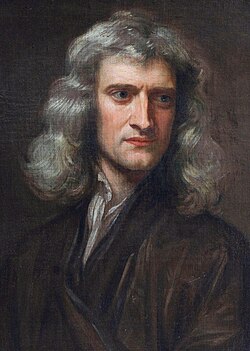
Examination in mathematics was once compulsory for all undergraduates studying for the Bachelor of Arts degree, the main first degree at Cambridge in both arts and sciences. From the time of Isaac Newton in the later 17th century until the mid-19th century, the university maintained an especially strong emphasis on applied mathematics, particularly mathematical physics. The exam is known as a Tripos.[15] Students awarded first-class honours after completing the mathematics Tripos are termed wranglers, and the top student among them is the Senior Wrangler The Cambridge Mathematical Tripos is competitive and has helped produce some of the most famous names in British science, including James Clerk Maxwell, Lord Kelvin and Lord Rayleigh.[16] However, some famous students, such as G H Hardy, disliked the system, feeling that people were too interested in accumulating marks in exams and not interested in the subject itself.
Pure mathematics at Cambridge in the 19th century had great achievements but also missed out on substantial developments in French and German mathematics. Pure mathematical research at Cambridge finally reached the highest international standard in the early 20th century, thanks above all to G H Hardy and his collaborator, J E Littlewood. In geometry, W V D Hodge brought Cambridge into the international mainstream in the 1930s.
Although diversified in its research and teaching interests, Cambridge today maintains its strength in mathematics. Cambridge alumni have won six Fields Medals and one Abel Prize for mathematics, while individuals representing Cambridge have won four Fields Medals.[17] The University also runs a Master of Advanced Study course in mathematics.
Modern period

After the Cambridge University Act formalized the organizational structure of the University, the study of many new subjects was introduced, such as theology, history and modern languages.[18] Resources necessary for new courses in the arts, architecture and archaeology were generously donated by Richard Fitzwilliam of Trinity College.[19] Between 1896 and 1902, Downing College sold part of its land to build the Downing Site, comprising new scientific laboratories for anatomy, genetics and Earth sciences.[20] During the same period, the New Museums Site was erected, including the Cavendish Laboratory, which has since moved to the West Cambridge Site, and other departments for chemistry and medicine.[21]
Teaching was heavily disrupted during the First World War in which more than 14,000 members of the University took part and 2,470 died. As a consequence, new state funding started to flow to the institution.[22] Following the Second World War, the University saw a rapid expansion of student numbers and available places; this was partly due to the success and popularity gained by many Cambridge scientists.[23]
Contributions to the advancement of science
Many of history's most important scientific discoveries were made by Cambridge alumni. These include:
- Articulation of the scientific method, by Francis Bacon
- Discovery of the laws of motion and the calculus, by Sir Isaac Newton
- Discovery of hydrogen, by Henry Cavendish
- Fundamental contributions to thermodynamics, by Lord Kelvin
- Formulation of the laws of electromagnetism, by James Clerk Maxwell
- Discovery of the electron, by J. J. Thomson
- Discovery of the atomic nucleus, by Ernest Rutherford
- Discovery of evolution by natural selection, by Charles Darwin
- Fundamental contributions to the Modern Synthesis of Darwinian evolution and Mendelian genetics, by Ronald Fisher
- Formulation of the theory of computation, by Alan Turing
- Discovery of the DNA double helix by Francis Crick and James D Watson
- Fundamental contributions to quantum mechanics, by Paul Dirac
- Fundamental contributions to cosmology, by Stephen Hawking
- Fundamental contributions to string theory, by Michael Green
Women's education
Initially, only male students were enrolled into the university. The first colleges for women were Girton College (founded by Emily Davies) in 1869 and Newnham College in 1872 (founded by Anne Clough and Henry Sidgwick), followed by Hughes Hall in 1885 (founded by Elizabeth Phillips Hughes as the Cambridge Teaching College for Women), New Hall (later renamed Murray Edwards College) in 1954, and Lucy Cavendish College in 1965.
The first women students were examined in 1882 but attempts to make women full members of the university did not succeed until 1948.[24] Women were allowed to study courses, sit examinations, and have their results recorded from 1881; for a brief period after the turn of the twentieth century, this allowed the "steamboat ladies" to receive ad eundem gradum|ad eundem degrees from the University of Dublin.[25]
Starting with Churchill, Clare and King's Colleges, all of the men's colleges began to admit women between 1972 and 1988. One women's college, Girton, also began to admit male students from 1979, but the other women's colleges did not follow suit. As a result of St Hilda's College, Oxford, ending its ban on male students in 2008, Cambridge is now the only remaining United Kingdom University with colleges which refuse to admit males; Newnham, Murray Edwards and Lucy Cavendish.
Myths, legends and traditions
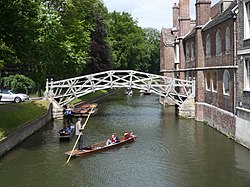
As an institution with such a long history, the University has developed a large number of myths and legends. The vast majority of these are untrue, but have been propagated nonetheless by generations of students and tour guides.
A discontinued tradition is that of the wooden spoon, the 'prize' awarded to the student with the lowest passing grade in the final examinations of the Mathematical Tripos. The last of these spoons was awarded in 1909 to Cuthbert Lempriere Holthouse, an oarsman of the Lady Margaret Boat Club of St John's College. It was over a yard in length and had an oar blade for a handle. It can now be seen outside the Senior Combination Room of St John's. Since 1909, results were published alphabetically within class rather than score order. This made it harder to ascertain who the winner of the spoon was (unless there was only one person in the third class), and so the practice was abandoned.
The Festival of Nine Lessons and Carols has been a Christmas choral service performed by the Choir of King's College, Cambridge since 1918, and it is broadcast each Christmas Eve by the BBC on radio and television. The radio broadcast has been a national Christmas tradition since it was first transmitted in 1928; this is carried worldwide by the BBC World Service and is also syndicated to hundreds of radio stations in the United States. The first television broadcast of the festival was in 1954.[26][27]
Location
The university occupies a central location within the city of Cambridge, with the students taking up a significant proportion (nearly 20%) of the town's population and heavily distorting the age structure.[28] Most of the older colleges are situated nearby the city centre and River Cam, along which it is traditional to punt in order to appreciate the buildings and surroundings.[29]
Examples of notable buildings include King's College Chapel,[30] the history faculty building[31] designed by James Stirling; and the Cripps Building at St John's College.[32] The brickwork of several of the colleges is also notable: Queens' College contains "some of the earliest patterned brickwork in the country"[33] and the brick walls of St John's College provide examples of English bond, Flemish bond and Running bond.
"Town and Gown"
The relationship between the university and the city has not always been positive. The phrase Town and Gown is employed to differentiate inhabitants of Cambridge from students at the university. There are many stories of ferocious rivalry between the two: in 1381, strong clashes brought about attacks and looting of university properties while locals contested the privileges granted by the government to the academic staff. Following these events, the Chancellor was given special powers allowing him to prosecute the criminals and re-establish order in the city. Attempts to reconcile the two groups followed over time.
In the 16th century agreements were signed in order to improve the quality of streets and student accommodation around the city. However, this was followed by new confrontations when the plague hit Cambridge in 1630 and colleges refused to help those affected by the disease by locking their sites.[34]
Nowadays, these conflicts have somewhat subsided and the University has become an opportunity for employment among the population, providing an increased level of wealth in the area.[35] The enormous growth in the number of high-tech, biotech, providers of services and related firms situated near the town has been termed the Cambridge Phenomenon: the addition of 1,500 new, registered companies and as many as 40,000 jobs between 1960 and 2010 has been directly related to the presence and importance of the educational institution.[36]
Organisation

Cambridge is a collegiate university, meaning that it is made up of self-governing and independent colleges, each with its own property and income. Most colleges bring together academics and students from a broad range of disciplines, and within each faculty, school or department within the university, academics from many different colleges will be found.
The faculties are responsible for ensuring that lectures are given, arranging seminars, performing research and determining the syllabi for teaching, overseen by the General Board. Together with the central administration headed by the Vice-Chancellor]], they make up the entire Cambridge University. Facilities such as libraries are provided on all these levels: by the University (the Cambridge University Library), by the Faculties (Faculty libraries such as the Squire Law Library), and by the individual colleges (all of which maintain a multi-discipline library, generally aimed mainly at their undergraduates).

The Senate consists of all holders of the MA degree or higher degrees. It elects the Chancellor and the High Steward, and unto 1950 it elected two members of the House of Commons. Up to 1926, the Senate was the University's governing body, fulfilling the functions that the Regent House fulfils today.[37]
The Regent House is the University's governing body, a direct democracy comprising all resident senior members of the University and the Colleges, together with the Chancellor, the High Steward, the Deputy High Steward, and the Commissary.[38] The public representatives of the Regent House are the two Proctors, elected to serve for one year, on the nomination of the Colleges.
Collections
Libraries


The university has 114 libraries.[39] The Cambridge University Library is the central research library, which holds over 8 million volumes. It is a legal deposit library, therefore it is entitled to request a free copy of every book published in the United Kingdom and Ireland.[40]
In addition to the University Library and its dependents, every faculty has a specialised library; for example, the History Faculty's Seeley Historical Library possesses more than 100,000 books. Furthermore, every college has a library as well, partially for the purposes of undergraduate teaching, and the older colleges often possess many early books and manuscripts in a separate library. For example, Trinity College's Wren Library has more than 200,000 books printed before 1800, while Corpus Christi College's Parker Library possesses one of the greatest collections of mediæval manuscripts in the world, with over 600 manuscripts.
Museums
Cambridge University operates eight arts, cultural, and scientific museums, and a botanic garden.[41] The Fitzwilliam Museum, is the art and antiquities museum, the Kettle's Yard is a contemporary art gallery, the Museum of Archaeology and Anthropology, University of Cambridge|Museum of Archaeology and Anthropology houses the University's collections of local antiquities, together with archaeological and ethnographic artefacts from around the world, the Cambridge University Museum of Zoology houses a wide range of zoological specimens from around the world and is known for its iconic finback whale skeleton that hangs outside. This Museum also has specimens collected by Charles Darwin. Other museums include, the Museum of Classical Archaeology, the Whipple Museum of the History of Science, the Sedgwick Museum of Earth Sciences which is the geology museum of the University, the Polar Museum, part of the Scott Polar Research Institute which is dedicated to Captain Scott and his men, and focuses on the exploration of the Polar Regions.
The Cambridge University Botanic Garden is the botanic garden of the University, created in 1831.

Formal Halls and May Balls
One of the most distinguishing aspects of student life at Cambridge is the possibility to take part in formal dinners at college. These are called Formal Hall and occur regularly during term time. Students sit down for a meal in their gowns, while Fellows eat separately on High Table: the beginning and end of the function is usually celebrated with a prayer. Special formals are organized for events such as Christmas or the Commemoration of Benefactors.[42]
After the exam period, May Week is held and it is customary to celebrate by attending May Balls. These are all-night long parties held in the colleges where food and drinks are served and entertainment is provided. Suicide Sunday, the first day of May Week, is a popular date for organizing garden parties.[43]
Pictures
-
The Great Gate of Trinity College
-
Corpus Christi College New Court
-
Clare College Old Court
-
Gonville and Caius College
-
Pembroke College
-
St Catharine's College
-
Clare Hall College
-
Downing College East Range
-
The Pepys Library, Magdalene College
-
Selwyn College Old Court
-
Jesus College Chapel
-
St John's College Great Gate
-
The entrance to Trinity Hall
-
The Cavendish Building, Homerton College
-
Darwin College
-
The Chapel of Sidney Sussex College
Outside links
| ("Wikimedia Commons" has material about University of Cambridge) |
- Universiy of Cambridge
- Cambridge University Students' Union
- Cambridge University Graduate Union
- Interactive map—a zoomable map linking to all the University departments and colleges
- University of Cambridge Nobel Laureates
References
- ↑ Kershaw, Alison (5 September 2011). "Cambridge named as best university in the world". The Independent. http://www.independent.co.uk/news/education/education-news/cambridge-named-as-best-university-in-the-world-2349326.html. Retrieved April, 2013.
- ↑ "A Brief History: Early records". University of Cambridge. http://www.cam.ac.uk/univ/history/records.html. Retrieved 17 August 2008.
- ↑ University of Cambridge: Nobel Prizes - excludes researchers at the MRC Laboratory of Molecular Biology after 1962 without a college or university affiliation.
- ↑ "Information about Churchill College". Churchill College. http://www.chu.cam.ac.uk/the_college/info/. Retrieved 7 January 2008.
- ↑ "About St. Catharine's College". University of Cambridge. http://www.cam.ac.uk/admissions/undergraduate/colleges/stcatharines/. Retrieved 8 September 2008.
- ↑ "Alternative Prospectus" (PDF). Cambridge University Students' Union. http://www.cusu.cam.ac.uk/prospective/prospectus/alternativeprospectus.pdf. Retrieved 8 September 2008.
- ↑ "Survey ranks colleges by green credentials". Varsity. http://www.societies.cam.ac.uk/cuecs/current_projects/LT/downloads/07-08/VARSITY_LTarticle08.JPG. Retrieved 8 September 2008.
- ↑ "About the Schools, Faculties & Departments". University of Cambridge. http://www.cam.ac.uk/deptdirectory/moreinfo.html. Retrieved 1 May 2010.
- ↑ Hilde De-Ridder Symoens (2003). Cambridge University Press. ed. A History of the University in Europe: Universities in the Middle Ages. 1. p. 89. ISBN 978-0-521-54113-8.
- ↑ 10.0 10.1 Hackett, M.B. (1970). The original statutes of Cambridge University: The text and its history. Cambridge University Press. p. 178. ISBN 9780521070768. http://books.google.com/books?id=7og8AAAAIAAJ&pg=PA178. Retrieved 2 September 2012.
- ↑ David Willey (journalist) (Easter 2012). "Vatican reveals Cambridge papers". Cam 66: 05.
- ↑ Charles Henry Cooper (1860). Memorials of Cambridge. 1. W. Metcalfe. p. 32. http://books.google.co.uk/books?id=7bQWAAAAIAAJ&printsec=frontcover#v=onepage&q&f=false. Retrieved 9 September 2012.
- ↑ Helmholtz, H.R. (2004) Roman Canon Law in Reformation England (Cambridge: University Press) pp.35,153
- ↑ Thompson, Roger, Mobility & Migration, East Anglian Founders of New England, 1629–1640, Amherst: University of Massachusetts Press, 1994, 19.
- ↑ A. R. Forsyth (1935). "Old Tripos days at Cambridge". The Mathematical Gazette (The Mathematical Association) 19 (234): 166. doi:10.2307/3605871.
- ↑ "The History of Mathematics in Cambridge". Faculty of Mathematics, University of Cambridge. http://www.maths.cam.ac.uk/about/history/. Retrieved 9 September 2012.
- ↑ The six alumni are Michael Atiyah (Abel Prize and Fields Medal), Enrico Bombieri, Simon Donaldson, Richard Borcherds, Timothy Gowers, Alan Baker and the four official representatives were John G Thompson, Alan Baker, Richard Borcherds, Timothy Gowers (see also "Fields Medal". Wolfram MathWorld. http://mathworld.wolfram.com/FieldsMedal.html. Retrieved 3 December 2009.)
- ↑ The National Archives, ed. "Cambridge University Act 1856". http://www.legislation.gov.uk/ukpga/Vict/19-20/88/contents. Retrieved 2 May 2012.
- ↑ University of Cambridge, ed. "Biography - The Hon. Richard Fitzwilliam". http://www.fitzmuseum.cam.ac.uk/gallery/hiddenhistories/biographies/bio/love/fitzwilliam_biography.html. Retrieved 2 May 2012.
- ↑ Taylor 1994, p. 22
- ↑ Cambridge University Physics Society (1995). Cambridge University Physics Society. ed. A Hundred Years and More of Cambridge Physics. ISBN 978-0-9507343-1-6.
- ↑ University of Cambridge, ed. "The Revived University of the Nineteenth and Twentieth Centuries". http://www.cam.ac.uk/univ/history/19c.html. Retrieved 2 May 2012.
- ↑ University of Cambridge, ed. "The University after 1945". http://www.cam.ac.uk/univ/history/post1945.html. Retrieved 2 May 2005.
- ↑ "At last, a degree of honour for 900 Cambridge women". The Independent. 31 May 1998. http://www.independent.co.uk/news/at-last-a-degree-of-honour-for-900-cambridge-women-1157056.html. Retrieved 9 September 2012.
- ↑ "Trinity Hall's Steamboat Ladies". Trinity news. 14 March 2012. http://trinitynews.ie/trinity-halls-steamboat-ladies/. Retrieved 9 September 2012.
- ↑ "Choir that sings to the world". BBC. 24 December 2001. http://news.bbc.co.uk/1/hi/entertainment/arts/1703517.stm. Retrieved 8 September 2008.
- ↑ Baxter, Elizabeth (18 December 2009). "Carols from King's: Cambridge prepares for Christmas". Daily Telegraph. http://www.telegraph.co.uk/culture/tvandradio/6840413/Carols-from-Kings-Cambridge-prepares-for-Christmas.html. Retrieved April, 2013.
- ↑ "Cambridge City: Annual demographic and socio-economic report". Cambridgeshire County Council. April 2011. http://www.cambridgeshire.gov.uk/NR/rdonlyres/3B0B3A7B-E448-4D61-A853-0B5A1A467969/0/CambridgeCityDistrictReport2011.pdf. Retrieved 4 September 2012.
- ↑ "A brief history of Punting". Cambridge River Tour. http://www.cambridgerivertour.co.uk/history.php. Retrieved 4 September 2012.
- ↑ Vitullo-Martin, J. (19 December 2009). What the late Middle Ages wrought. The Wall Street Journal. Retrieved from http://online.wsj.com/article/SB10001424052748704517504574590023741272370.html
- ↑ Faculty of History. (n.d.) The Building. University of Cambridge website. Retrieved from http://www.hist.cam.ac.uk/directory/building
- ↑ English Heritage. (31 March 2009). Modernist building at St John's College Cambridge is listed. English Heritage website. Retrieved from http://www.english-heritage.org.uk/about/news/modernist-st-johns-cambridge-listed/
- ↑ Woodcock, N. & Norman D. (20 August 2010). Building Stones of Cambridge: A walking tour around the historic city-centre. Department of Earth Sciences, University of Cambridge website. Retrieved from http://www.esc.cam.ac.uk/teaching/geological-sciences/building-stones-of-cambridge
- ↑ Shepard, Alexandra; Phil, Withington (2000). Manchester University Press. ed. Communities in Early Modern England: Networks, Place, Rhetoric. pp. 216–234. ISBN 978-0-7190-5477-8. http://books.google.co.uk/books?id=xLkULGOljPsC&printsec=frontcover#v=onepage&q&f=false. Retrieved 4 September 2012.
- ↑ "Is Town v Gown a thing of the past?". Cambridge News. 7 October 2008. http://www.cambridge-news.co.uk/Home/Features/Is-Town-v-Gown-a-thing-of-the-past.htm. Retrieved 4 September 2012.
- ↑ "What is the Cambridge Phenomenon?". Cambridge Phenomenon. http://www.cambridgephenomenon.com/what-phenomenon/. Retrieved 4 September 2012.
- ↑ "University of Cambridge: how the University works". Cam.ac.uk. 2011-06-20. http://www.cam.ac.uk/univ/works/senate.html. Retrieved 2013-02-04.
- ↑ Statutes and Ordinances, 2007–2008
- ↑ "Facilities and resources". Cambridge Admissions Office. http://www.cam.ac.uk/admissions/undergraduate/courses/facilities.html. Retrieved 3 January 2013.
- ↑ "Legal Deposit in the British Library". The British Library. http://www.bl.uk/aboutus/stratpolprog/legaldep/. Retrieved 3 January 2013.
- ↑ "Museums & Collections". University of Cambridge. http://www.cam.ac.uk/museums/. Retrieved 3 January 2013.
- ↑ "Inside Cambridge: Fizz, Fellows and Formal Hall". The Huffington Post. 5 January 2012. http://www.huffingtonpost.co.uk/anna-sheinman/cambridge-formals_b_1180791.html. Retrieved 25 April 2012.
- ↑ "Living in Cambridge". Catalog. http://www.catalog.group.cam.ac.uk/cambridge.html. Retrieved 25 April 2012.
Books
- Leedham-Green, Elisabeth (1996). A concise history of the University of Cambridge. Cambridge University Press. ISBN 978-0-521-43978-7.
- Leader, Damien (1988–2004). A history of the University of Cambridge. Cambridge University Press. ISBN 978-0-521-32882-1.
- Stubbings, Frank (1995). Bedders, bulldogs and bedells: a Cambridge glossary. Cambridge University Press. ISBN 978-0-521-47978-3.
- Smith, J.; Stray, C. (2001). Teaching and Learning in 19th century Cambridge. Boydell Press. ISBN 978-0-85115-783-2.
- Willis, Robert (1988). Clark, John Willis. ed. The Architectural History of the University of Cambridge and of the Colleges of Cambridge and Eton. Cambridge University Press. ISBN 978-0-521-35851-4.
- Deacon, Richard (1985). The Cambridge Apostles: A History of Cambridge University's Elite Intellectual Secret Society. Cassell. ISBN 978-0-947728-13-7.
- Garrett, Martin (2004), 'Cambridge: a Cultural and Literary History', Signal Books. ISBN 1-902669-79-7
- A history of the University of Cambridge, by Christopher N.L. Brooke, Cambridge University Press, 4 volumes, 1988–2004, ISBN 0-521-32882-9, ISBN 0-521-35059-X, ISBN 0-521-35060-3, ISBN 0-521-34350-X
- "Japanese Students at Cambridge University in the Meiji Era, 1868–1912: Pioneers for the Modernization of Japan". http://www.dhs.kyutech.ac.jp/~ruxton/hatenkou.html. Retrieved 8 August 2009., by Noboru Koyama, translated by Ian Ruxton, A Translation from a Japanese Original. Lulu Press. 2004. ISBN 1-4116-1256-6. http://www.prweb.com/releases/2005/1/prweb201396.htm. This book includes information about the wooden spoon and the university in the 19th century as well as the Japanese students.
- Webb, Grayden (2005). The History of the University of Cambridge and Education in England. Cambridge University Press. ISBN 0-521-32882-9.
- Anonymous (2009) [1790]. A Concise and Accurate Description of the University, Town and County of Cambridge. Cambridge University Press. ISBN 978-1-108-00065-9.
- Taylor, Kevin (1994). Central Cambridge: A Guide to the University and Colleges. Cambridge University Press. ISBN 978-0-521-45913-6.




































